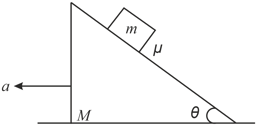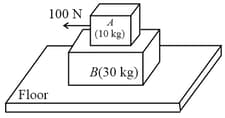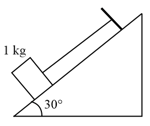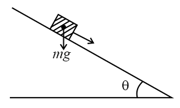A block of mass is at rest relative to a stationary wedge of mass . The coefficient of friction between the block and the wedge is . The wedge is now pulled horizontally with an acceleration , as shown in the figure. Then, the minimum magnitude of for the friction between the block and the wedge to be zero, is


Important Questions on Friction

Given in the figure are two blocks and of weight and , respectively. These are being pressed against a wall by a force and kept in equilibrium as shown. If the coefficient of friction between the blocks is and between block and the wall is , the frictional force applied by the wall on block is:
A slab B rests on a frictionless floor as shown in the figure. A block A rests on top of the slab- B. The coefficients of static and kinetic friction between the block A and the slab B are and respectively. When block-A is acted upon by a horizontal force of , as shown, find the resulting acceleration of the slab- B.


The coefficient of static friction between two blocks is and the table is smooth. The maximum horizontal force that can be applied to move the blocks together is _______ (take

As shown in the figure, a block of mass is kept on a horizontal rough surface of coefficient of friction . The critical force to be applied on the vertical surface as shown at an angle with horizontal such that it does not move, will be . The value of will




